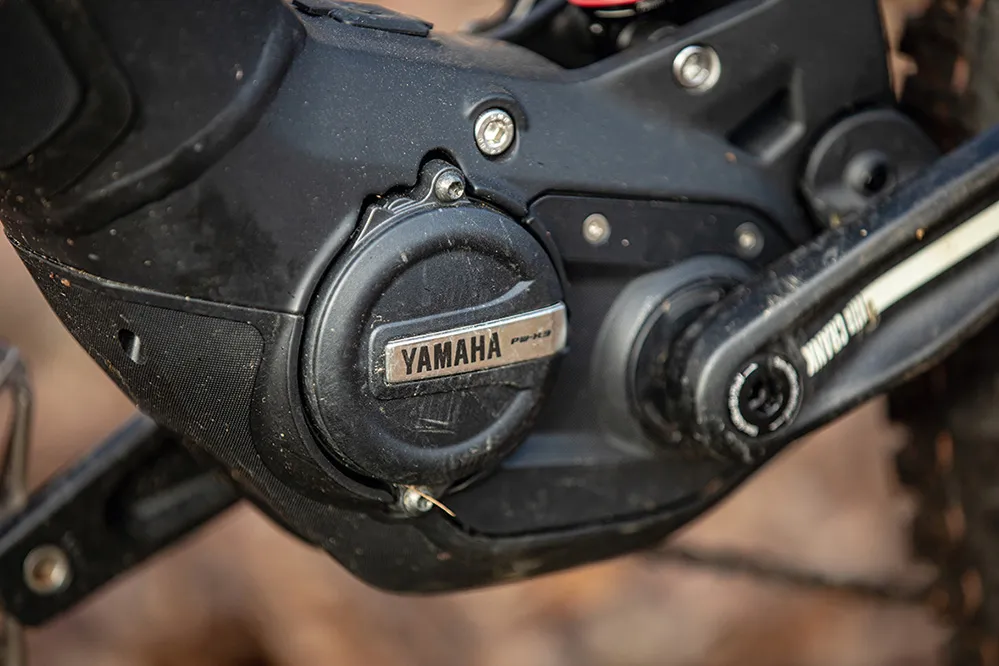Haibike was one of the first bike manufacturers to bring a 'proper' electric mountain bike to market, way back in 2010, and one of the key brands behind the e-MTB boom.
The brand designs and engineers a huge range of electric bikes in Germany, including the NDURO, aimed at hard-hitting enduro and all-mountain (in both directions) riding.
This latest model shows how far electric mountain bikes have come in the past decade.
Haibike NDURO 6 frame and motor

In place of the Bosch or Shimano electric bike motors found on most e-MTBs, the NDURO 6 uses Yamaha’s latest drive unit, the 2023 PW-X3. With four assistance modes and 85Nm of torque, this has a claimed peak power output of more than 500W, so can deliver up to 360 per cent assistance.
Not only is it more potent than the previous-generation Yamaha motor, but it’s 20 per cent smaller and 10 per cent lighter. It’s controlled via Yamaha’s Side Switch remote, which has a big 1.7in display, but is nicely low-profile, easy to read and sits close to the bar.
The motor is accommodated tidily underneath a long, fully integrated down-tube battery, which is removable via a key/lock system for off-the-bike charging. This is the Japanese corporation’s largest ebike power supply yet, with a 720Wh capacity.
Haibike has had to make the aluminium frame seriously fat to fit everything inside. While it still sports the brand’s signature angular lines, the top tube hump and frame kinks have been toned down a little compared to older models.
Updates for 2023 include modern longer/slacker geometry, with a 63.5-degree head angle, 480mm reach (large) and lengthy wheelbase.
Combined with 180mm of four-bar linkage rear travel and a matching fork, this should keep the rider feeling assured while dealing with the serious impacts associated with riding a beefy ebike downhill fast.
Haibike NDURO 6 spec details

The NDURO 6’s relatively affordable (for an ebike) price isn’t reflected only in the motor, but also the parts spec.
Up-front is a burly RockShox Domain R, not the brand's top-end ZEB fork, and the shock is their most basic Deluxe Select model.
TRP’s Slate four-piston brakes aren’t quite as powerful as the Shimano or SRAM equivalent, even when combined with the superb bite of the Schwalbe Big Betty rear tyre.
Both tyres have the ‘in-between’ Super Trail casing, rather than a thicker/tougher carcass more suitable for a long-travel ebike.
The mostly SRAM SX Eagle drivetrain loses a little gearing range at both ends and feels a little sloppier compared to the brand’s higher-end kit.
Urgency is further reduced by the fat, heavy, double-wall WTB rims on own-brand hubs, although the wheels at least proved hard to dent or damage.
Haibike NDURO 6 geometry
| | S | M | L | XL |
|---|---|---|---|---|
| Seat angle (degrees) | 77 | 77 | 77 | 76.9 |
| Head angle (degrees) | 63.5 | 63.5 | 63.5 | 63.5 |
| Chainstay (mm) | 460 | 460 | 460 | 460 |
| Top tube (mm) | 574 | 604 | 631 | 663 |
| Head tube (mm) | 120 | 120 | 130 | 140 |
| Bottom bracket drop (mm) | 5 | 5 | 5 | 5 |
| Wheelbase (mm) | 1,245 | 1,257 | 1,305 | 1,339 |
| Stack (mm) | 644 | 644 | 653 | 662 |
| Reach (mm) | 425 | 455 | 480 | 510 |
Haibike NDURO 6 ride impressions

Haibike has nailed the NDURO’s sizing, seated climbing position and geometry, and the alloy chassis is super-stiff.
The bottom bracket is a tad higher than on most rivals, which gives good ground clearance when smashing down rough, straight-line bridleways and high-speed, wide-open descents, especially with the NDURO’s deep suspension egging you on, by making you feel safe and planted.

Unfortunately, if you’re more interested in flowing down singletrack, linking turns, playing about on off-piste tracks or trying to solve the most fun and technical climbing puzzles, the massive weight of the bike – over 27.5kg – detracts from the riding experience.
Mixed wheel-size rigs get touted as nimbler and more manoeuvrable, but the NDURO is one of the hardest bikes I’ve ever ridden to change direction on quickly.
It’s so stable at speed and glued to the ground that it’s hard to do anything but arc smoothly through turns, and also practically impossible to manual or get the wheels off the ground without the aid of a lip or feature to launch off. This isn’t a machine that encourages messing about.

With its long 460mm chainstays and pokey motor, you might expect the NDURO to be a beast up the climbs, but, again, its weight comes into play.
While it’s got some juice to it, the Yamaha drive unit has its work cut out and feels as though it has less sheer grunt on peak-power uphill efforts than Bosch and Specialized’s motors, which give smoother, less cadence-sensitive assistance.
I had intermittent issues with the buttons freezing, too, which meant having to turn the bike off and back on to change modes.
The latest motor also shares its predecessor’s annoying habit of ‘revving’ and trembling forwards under power when you’re sat chatting to mates and resting on the leading pedal – something other brand’s drive units don’t do.
One bonus of the super-solid chassis is zero flex or deflection from your line, even when chucking it down proper DH tracks or rocky descents.
This gives an overall riding sensation more like a motorbike without an engine, which some folk may like. I prefer more reactive handling, though.
Haibike NDURO 6 bottom line

This is the first bike I’ve tested where you have to remove the front wheel to weigh it on (25kg max) workshop scales, but it's unclear why it’s quite so heavy.
Yes, it has a big battery and the fat-legged Domain fork clocks in at over 2.5kg, but many of the other parts are ebike-typical and the Super Trail tyres are lighter than most.
For comparison, the cheapest Vitus E-Sommet has only 10mm less travel and is a massive 3kg lighter.
The huge weight brings with it massive solidity, but the NDURO rides like a bit of a streamroller and lacks agility.
Product
| Brand | haibike |
| Price | 5799.00 EUR,4899.00 GBP |
| Weight | 27.6000, KILOGRAM () - as tested |
Features
| Fork | RockShox Domain R, 180mm travel |
| br_stem | Haibike, 50mm |
| br_frame | Aluminium alloy, 180mm travel |
| br_motor | Yamaha PW-X3 w/ 720Wh battery |
| Tyres | Schwalbe Magic Mary EVO Super Trail ADDIX Soft 29x2.4in (f) and Schwalbe Big Betty Super Trail 27.5x2.6in (r) |
| br_brakes | TRP Slate G-Spec, 203mm rotors |
| br_cranks | Haibike Components |
| br_saddle | Selle Royal Vivo |
| br_wheels | WTB ST i30 TCS on Haibike hubs |
| br_headset | Acros |
| br_shifter | Sram, SX Eagle |
| br_cassette | SRAM Eagle |
| br_seatpost | Haibike dropper |
| br_gripsTape | Haibike, MTB grips |
| br_handlebar | Haibike, 780mm |
| br_rearShock | RockShox Super Deluxe Select |
| br_bottomBracket | Integrated in the motor |
| br_availableSizes | S, M, L, XL |
| br_rearDerailleur | Sram, SX Eagle |
